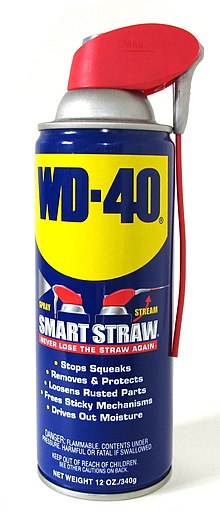Rocket Chemical Company
 |
|

WD-40 with Smart Straw
|
|
| Product type | Penetrating oil |
|---|---|
| Owner | WD-40 Company |
| Country | San Diego, California, United States |
| Introduced | 1953 |
| Website | www |
WD-40 is the trademark name of a penetrating oil and water-displacing spray. The spray is manufactured by the San Diego, California–based WD-40 Company.
Different sources credit different men with inventing WD-40 formula in 1953 as part of the Rocket Chemical Company (later renamed to WD-40 Company), in San Diego, California; the formula was kept as a trade secret and was never patented.
According to Iris Engstrand, a historian of San Diego and California history at the University of San Diego, Iver Norman Lawson invented the formula, while the WD-40 company website and other books and newspapers credit Norman Larsen. "WD-40" is abbreviated from the term "Water Displacement, 40th formula", suggesting it was the result of the 40th attempt to create the product. The spray, composed of various hydrocarbons, was originally designed to be used by Convair to protect the outer skin which comprised the paper-thin balloon tanks of the Atlas missile from rust and corrosion. These stainless steel fuel tanks were so fragile that when empty they had to be kept inflated with nitrogen to prevent them from collapsing. WD-40 was later found to have many household uses and was made available to consumers in San Diego in 1958.
It was written up as a new consumer product in 1961. By 1965 it was being used by airlines including Delta and United; United, for example, was using it on fixed and movable joints of their DC-8 and Boeing 720s in maintenance and overhaul. At that time, airlines were using a variant called WD-60 to clean turbines, removing light rust from control lines, and when handling or storing metal parts. By 1969 WD-40 was being marketed to farmers and mechanics in England.
The long-term active ingredient is a non-volatile viscous oil which remains on the surface to which it is applied, giving lubrication and protection from moisture. This oil is diluted with a volatile hydrocarbon to make a low viscosity fluid which can be aerosolized to penetrate crevices. The volatile hydrocarbon then evaporates, leaving behind the oil. A propellant (originally a low-molecular-weight hydrocarbon, now carbon dioxide) creates pressure in the can to force the liquid through the can's nozzle before evaporating.
...
Wikipedia
